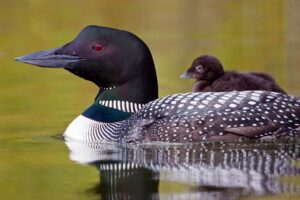photo courtesy of Wisconsin Raptor Group
On this northern Wisconsin farm, cows gawk with curiosity at a visitor that fell from the sky to land in their cow pen. The loon (left foreground) was saved and nurtured back to health by members of the Wisconsin Raptors Group.
by Dennis Dalman
As much as Kaia Swenson loves to see Minnesota’s state bird, the loon, (and hear its haunting call), she kept hoping one day in mid-April a loon on a pond by her home would just fly away, just begone.
Swenson was deeply worried about the bird because it seemed to be stranded on that pond, trying over and over again to fly but apparently not gaining enough height to remain airborne.
Swenson lives in the Rolling Meadows neighborhood in Sartell where there is a large holding pond, dubbed “Brian’s Lake.”
“I watched for 15-20 minutes as the loon tried to take off,” she said in an interview with the Newsleader. “The lake appeared to be not long enough for the loon to gain the height needed for takeoff.”
Worried about the poor bird’s plight, Swenson made a number of phone calls – to the police, then to the Highway Patrol, who transferred her call to the Department of Natural Resources. After that, she did online research and finally located a couple in Tomahawk, Wis. – Kevin and Linda Grenzer – who are dedicated to saving all sorts of birds, including loons.
She called that couple and was told there’s not much that can be done. After explaining the pond/lake is about 100 yards wide, max, the couple told her that should be long enough to enable the loon to fly up from it, especially if there is a strong headwind. Swenson’s hopes soared as she continued to watch and enjoy the sight of that beautiful bird floating and diving.
She thanked the couple, then she watched and waited, hoping so much the loon would succeed. It didn’t, as her hopes started to sink.
Swenson is an early-education teacher in the St. Cloud School District. When she returned home from work the next day, her spirit instantly lifted when she noticed the loon was gone. She even took three walks around the big pond, looking and looking. No loon!
“I was so happy,” she said. “That made my day!”
Swenson recalled her youthful happy trips to Minnesota’s Boundary Canoe Waters area where she often observed loons and their lonesome calls. She didn’t know a lot about the particular bird, but after the loon’s crisis at the pond, she has learned a lot, including the awful news that in some areas, especially northern Wisconsin, some loons have been “falling from the sky.”
Why the crisis?
Because of odd, mixed-up, unseasonal conditions during this so-called spring, atmospheric conditions at high altitudes are causing ice to build up on migrating loons’ (and grebes’) bodies. That causes them to forsake the sky and make “emergency landings,” stranding them on the ground or on watery places that are not large enough for them to fly off again. They become stranded because loons cannot walk. Their “feet” toward the backs of their bodies are for swimming only, like paddles.
The Raptor Education Group in Antigo, Wis. has received several calls from people noticing loons stranded on the ground. In northern Wisconsin, one of them landed on a barn’s outdoor muddy cow enclosure with a bunch of cows standing there gawking at the strange visitor. Thanks to the Raptor Group, that loon was rescued and nursed back to health. Group members, calling the recent tragic phenomenon “loon fallout,” have rescued many more loons and pie-billed grebes after people called in about the stranded birds.
When loons or grebes make hard “emergency” landings on waterless ground, they are often injured in the process, including abrasions on their “feet” and fractured keel bones, legs and wings.
What to do
The Raptor Education Group gives the following advice to people:
• Be careful approaching loons. Their beaks are sharp, and the birds might react defensively.
• If you do rescue one, make sure you use a thick, large blanket to cover it before putting it in a box or carrier. To protect the loon from further injury, line the bottom of the carrier with towels or blankets and punch holes in the top of the box or carrier before putting the bird into it.
• Before or after such a rescue, call the Department of Natural Resources for advice on who to contact to help save and rehabilitate the loon – or grebe. The DNR’s phone numbers are 651-296-6157 or 888-MINNDNR (646-6367). Its email address is info.dnr@state.mn.us.
According to the DNR, about 12,000 loons migrate to Minnesota every year, second only to Alaska. A loon can live to be up to 30 years old.
There are five types of loon, with the “Common Loon” being – well – the most common. It weighs anywhere from 6-14 pounds, has an average wingspan of 41 to 52 inches and can fly as fast as 70 mph. Loons eat lots of fish, as well as insects and crustaceans, diving and swimming underwater to catch their prey. They can dive as deep as 250 feet.

A beautiful loon floats placidly with a chick on its back.




